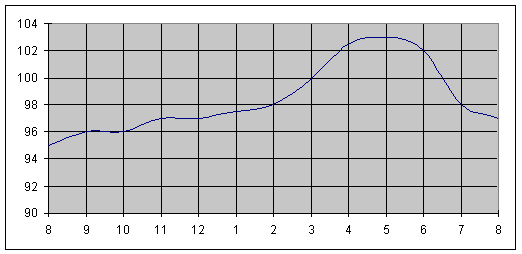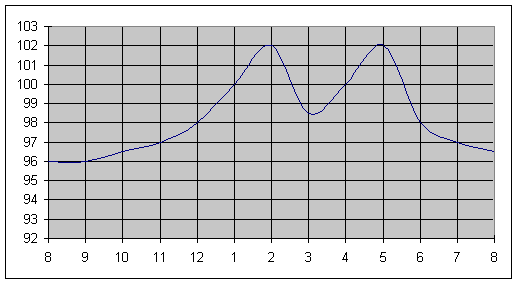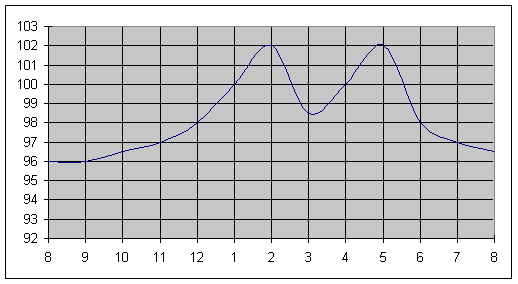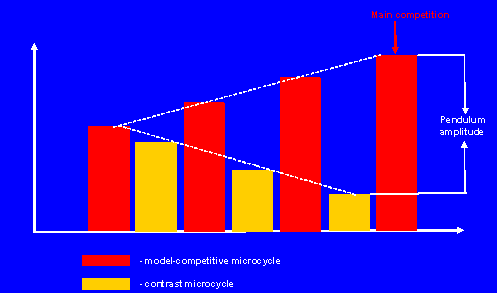

Periodisation: Myth and Reality
Introduction
Valery Obidko explains the fundamentals of periodisation for the extensive training cycles.
In an extensive training cycle (such as annual or semi-annual), there are, as usual, three periods: preparatory, competitive, and transition. Initially, the competition calendar and climatic conditions were considered reasons for the periodical changes in the training process. However, a thorough analysis has shown that neither these nor some other external factors determine the essence of training; these factors are insufficient to explain periodization fundamentals. An important point to recognize is that, according to a concept by the Soviet experts (Novikov A.D., Matveev L. P., Ozolin N. G., and Farfel V. S.), the reasons for the cyclic alteration of training periods are, first of all, the regularities of athletic shape development.
Athlete's adaptation to training effects
In modern sports, performance improvement depends upon proper physical, technical, psychological, and tactical preparedness levels. Different means and methods exist to achieve this high level of readiness.
It is accepted that adaptation is one of the primary forms of existence of living things. This term refers to a human being's general biological ability to adapt to various external and internal stresses. Human beings' interaction with nature changes their views. We monitor this phenomenon in a sporting practice every day. Affecting the organism's systems by a particular combination of training loads, we cause corresponding changes in a specific direction.
Each adaptation process may lead to purposeful changes in the organism's whole system and separate muscle groups. The athlete's body systems are balanced in an external and internal environment through the adaptation processes. The organism exists while it can adapt to the surrounding environment (Pavlov I. P., 1924). As soon as this balance is broken, the organism no longer exists.
The state of balance is achieved through adaptation, which goes on throughout life. Thus, adjustment is necessary because humans cannot live without this process. In a sporting practice, adaptation processes occur as follows: at a given time, the coach suggests to the athlete one or another combination of training loads, to which the athlete adapts after some time. In other words, the athlete changes his corresponding body systems (i.e., neuromuscular system, respiratory system, etc.), enhancing his functional abilities.
Practically, sporting performances rise until the athlete's body adapts to a specific combination of training effects. Adapting certain training combinations ends when an athlete obtains the so-called athletic shape. It means the body has adapted (changed its functions) to the given training loads. Reorganizing the organism again is necessary for further improvement of results. For that purpose, new and more efficient training means and methods have to be used in the training process.
Each stage of sporting perfection suits its stage of adaptation. One combination of training loads is suitable for one sporting performance level, but inefficient for different performance levels. The degree of training affecting the athlete's body systems has to increase with a higher level of the athlete's performance.
The athletic shape and its criteria
The athletic shape is a state of optimal (best) readiness for sporting performance, which is acquired under specific conditions in each big training cycle (annual or semi-annual) (Matveev L. P., 1977). The athletic shape represents a harmonious unity of all components of the athlete's optimal readiness: physical, psychological, technical, and tactical. An athlete is in athletic shape only when all these components are present.
No matter how high an athlete's physical preparedness is and how perfect his technical and tactical skills are, he will not demonstrate high performance in essential competitions if the athlete does not have adequate psychological preparedness. Therefore, the athletic shape is characterised by various characteristics and the balanced ratio of the four parameters.
It is crucial to appreciate that optimal readiness is relative. In a sense, it is part of a process of sporting perfection: it is correct for each given cycle of athletic shape development only. As the athlete improves results, these optimum changes—athletic shape—are qualitative and quantitative.
Actual competition results are the main integral parameters of athletic shape. Only sporting results can reveal all aspects of the athlete's readiness for high performance. However, results are a significant parameter of athletic build only when demonstrated with a specific frequency in comparable conditions and evaluated objectively. The selection of qualitative criteria for the muscular body has a significant theoretical and practical meaning. In this regard, studies have shown that there are two groups of such standards: progress criteria and stability criteria.
Progress criteria characterize athletic shape by the degree of increment and absolute level of the athlete's performance in a given training cycle. Parameters here, in particular, might be:
- Differences between the personal best achieved in a previous training cycle and the performance in the current event. The more the latter is better than (exceeds) the last cycle's result, the higher the possibility that the athlete is in a state of athletic shape, and vice versa. However, the athlete's training record and best results must be considered. Athletes with a long training record (7 to 10 years) and an outstanding personal best result often have no increment in their performance level in a given training cycle. Repetition of the athlete's personal best result or a result close to personal best can be a conditional criterion of athletic shape (within 1 to 3% of personal best, depending on the specifics of the sport).
- The difference between the considered result of a control competition and the results of the first competitions in a given big training cycle is that the more the athlete exceeds his results shown in the first competitions, the higher the possibility that the athlete is nearing a state of his athletic shape.
The following parameters can be considered as stability criteria:
- The number of results demonstrated by an athlete within a so-called rated zone of athletic shape. The lower limit of this zone must not significantly deviate from the personal best result for the high-class athlete. For example, in cyclic sporting events (excluding long distances), the lower limit of a zone of athletic shape is a result, which is about 98 to 98.5% of a personal best result; in acyclic sporting events, the zone is not less than 95 to 97% of a personal best result. In other words, if an athlete (fully mobilizing his forces and without unusual interferences) shows results below this level, it speaks that an athlete is not in a state of athletic shape (they are out of shape). However, if the athlete's competition results are higher than a given level, he is in athletic shape. Recent evidence suggests high-performance athletes demonstrate up to 1/3 of all results within a given zone in the annual training cycle.
- The average time interval between results in a rated zone of athletic shape (i.e., the frequency of demonstration of results that are not below a lower limit of a given zone). The more the athlete can demonstrate such results in a given big training cycle, the shorter the interval between them, and the greater the athletic shape's stability.
- The total duration of the competitive period, during which sporting results with systematic participation in competitions do not drop below the level of the athletic shape zone.
These criteria are significant only if the athlete participates in competitions quite often. They are not informative if, for example, the athlete competes once a month. Still, they provide meaningful information if there are weekly competitions, which is typical for the competitive period of high-performance athletes.
Since different relations characterize the progress criteria and the stability of athletic shapes, the relationships between them are not uniform. The total number of competitions in one big training cycle is usually correlated positively with the increment and absolute level of performance. However, the number of essential competitions often negatively correlates with these parameters. It is important to remember that the state of athletic shape can be determined when all criteria are used to evaluate individual characteristics of an athlete's preparedness and specialised methods of functional control (medical, biological, psychological).
Phases of Athletic Shape Development suggest it has three different phases: acquisition, retention (or relative stabilisation), and temporary loss of athletic shape (Figure 1).

Figure 1. Athletic shape development (mono-cycle)

Figure 2. Athletic shape development (bi-cycle)
The first phase is the phase of the formation and improvement of conditions that are the basis of the state of athletic shape, and the first phase concludes with an integrated system of specific components. At this stage, the general level of the athlete's body's functional abilities is increased with a multilateral development of their physical and mental qualities and the formation and perfection of necessary motor skills. It seems reasonable to assume that performance levels due to athletic shape depend firstly on the quality of its foundation.

Figure 3. Athletic shape development (tri-cycle)
The relative stabilization of athletic shape characterizes the second phase as a system of components providing (ensuring) optimal readiness for sporting performances. A total restructuring of these components in a given phase is impossible because this would lead to a loss of athletic shape. However, with a process of athletic shape stabilization, all those factors that are essential for high sporting performances are further perfected. That is why results grow within limits, which the regularities of the given athletic shape allow.
The variations of results at this stage of athletic shape are common (figures 1, 2, and 3), that is because, on the one hand, the operative athlete's readiness is expediently regulated at the stages of his preparation and participation at different levels, and, on the other hand, the body's functional conditions periodically fluctuate at this particular stage. Such variations of results are not a sign of athletic shape loss (if their deterioration does not become a stable tendency).
The third phase is distinguished by direction changes in adaptational processes in the body's functional regime (rehabilitation, recuperation). Relationships and links that acquired athletic shape and stabilised earlier are now partially weakened or destroyed. However, this does not mean that the fundamental functions of the athlete's organism are violated. When an athlete's general life regime and training regime are organised rationally (correctly), the temporary loss of athletic shape does not affect the athlete's regular life activity.
Some athletes and coaches might ask: why cannot an athlete be permanently in a state of athletic shape? In this regard, studies have shown that, firstly, athletic shape acquired at one or another stage of an athlete's sporting career is a state optimal for this given stage. For the next higher stage, this state is no longer optimal. The athlete's desire to keep a once-acquired athletic shape would be similar to a desire to mark time. To advance, the athlete must eliminate his old athletic shape and create conditions for acquiring a new one. Many more changes and improvements are needed in the athlete's preparedness components.
Secondly, because of the prolonged effect of training and competitive loads necessary for acquiring and stabilising athletic shape, the body's protective reaction is developed sooner or later to prevent overstraining adaptation mechanisms. If a coach forgets these factors, the same loads that led to athletic shape will become stressors, producing overtraining.
Thirdly, maintaining a complex dynamic balance between biological functions and the processes guaranteeing athletic shape is challenging, especially for the athlete's central nervous system (CNS). This task becomes even more difficult because it must be resolved in the continual change of the organism's internal and external environment in the stressful conditions of sporting activity.
Thus, maintaining athletic shape is fraught with difficulties of both external and internal character. If athletes try to retain athletic shape for too long, they might become excessive, leading to unpredictable consequences. However, it is not necessary. On the contrary, conserving once-acquired athletic shapes would hinder acquiring new ones, i.e., it would be an obstacle to new performances.
Athletic Shape Maintenance
Many researchers have studied the problem of maintaining athletic shape since the early 1930s. Different authors have various recommendations. Some advocate increasing the duration of the preparatory period from 2 to 6-7 months because the stability of adaptational changes depends upon both the usage of a concrete combination of training loads and the length of their effects.
Former Soviet specialists designed the so-called 'Principle of Pendulum' (PP), Figure 5, for the distribution of training loads during the final (pre-competitive) stage of preparation for the main competitions (Arosiev D. A.). The Principle of Pendulum suggests the systematic alteration of two types of training microcycles - model-competitive and contrasting. The main aim of model-competitive microcycles is direct preparation for the main competition, and the aim of contrasting microcycles is compensation and super-compensation after the competition. More specific exercises are used in the first type of microcycle, and less specialised and less intensive exercises in the latter. In addition to model-competitive and contrasting microcycles, there are intermediate-developmental and maintenance microcycles. Thus, altering training helps maintain the athlete's athletic shape. In this regard, five different models of training have been studied at the retention phase of athletic shape (Bondarchuk A. P., 1991):
- Maintenance of the same volume and intensity of training loads using the same training means.
- Maintenance of volume with the growth of intensity.
- Lowering the volume (up to 50%) with the growth of intensity.
- The growth of volume (up to 50%) and the intensity of training.
- Change of training means (50%) and methods. Training intensity in models 2, 3 and 4 rose by 50%.
Changes made to the training combination, applied before the second acquisition of athletic shape, help maintain the present athletic shape level between 1 and 3 months. The athlete loses the state of athletic shape. In most cases, the duration of athletic shape retention does not exceed two months. Only in a few instances is this period slightly shorter (1 month) or slightly longer (3 months).
With the end of this period, the athlete has to change his training means if there is an aim of further maintenance of athletic shape. The optimal duration of athletic shape retention for all athletes is four weeks. In one study by Bondarchuk, one of the experimental groups changed the combination of training means every 3 to 4 weeks. In this experiment, athletes could be in athletic shape for five months.

Figure 5. The principle of the Pendulum at the pre-competitive phase of
preparation
Athletes' characteristics in the process of athletic shape retention differ not only by the duration of the retention period but also by the direction of the fluctuations of sporting performance. Thus, in the first two weeks, one group of athletes improved their results after changes in a combination of training loads. In the next two weeks, the tempo of improvement slightly decreased compared to the first two weeks (but the results were still in the 3% zone of retention). I
n the second group of athletes, the opposite trend of the results was observed: in the first two weeks, results were slightly lower, and in the following week, improvement by several per cent was observed. It seems reasonable to assume that there might be other reactions of the athlete's body systems to changes in combinations of training loads (i.e., specific dynamics of sporting results).
Athletic shape maintenance becomes possible because of adaptative changes in the corresponding system of the body. It seems likely that the body receives new stimuli for further functioning following new external conditions after a given time interval. Active rest becomes very important for the recovery process. Thus, active rest assists in athletic shape maintenance.
Temporary Loss of Athletic Shape
As mentioned, there are three phases of athletic shape development: acquisition, retention, and temporary loss. The loss of athletic shape can be either long-term or short-term. The long-term loss of athletic shape is observed in two cases:
- When an athlete is in a state of athletic shape and continues using the same combination of training means.
- When an athlete excludes one or the other exercise from a training process for a particular time (from one to several months) during periods of either acquisition or retention of athletic shape.
Athletes experience the loss of athletic shape in most cases after the transition period. At this time, results usually decrease by 5 to 10% (sometimes even more) compared to previous annual cycle results.
The short-term loss of athletic shape can be observed in the second period of athletic shape development. The duration of the loss varies from 2 to 8 weeks. The short-term reduction of performance levels during periods of athletic shape development after active or passive rest cannot be considered a loss of athletic shape. This phenomenon is part of athletic shape development (adaptation processes to training loads are a basis of athletic shape development).
Duration of Periods of Athletic Shape Development
As previously stated, the time needed for athletes to obtain a state of athletic shape varies from one individual to another. From one perspective, it depends upon the functionality of the athlete's body systems, and from the other side, it depends on incoming training effects and other factors. The duration of the acquisition of athletic shape depends on an athlete's age.
Thus, at the age of 20 to 30 years, this period is usually 2 to 8 months. When an athlete ages (older than 30), their athletic shape and acquisition are longer. The longer duration of the acquisition of athletic shape happens because of the mechanisms of the body systems' functioning. This concerns CNS and other systems (i.e., yielding of conditioned reflexes, the brain's chemical structure, etc.).
The duration of athletic shape development is increased with frequent alteration of training, which means that a period of athletic shape acquisition starts after active or passive rest. Sometimes, periods of athletic shape acquisition might be more extended when athletes use high-volume training loads. These periods also increase when interruptions between training lessons and micro and mesocycles of training (i.e., athletes' poor health conditions). The duration of preliminary general training (without using competitive exercise) does not affect (influence) the duration of athletic shape acquisition. The same is true in the case of simple and complex coordination exercises.
Phases of Athletic Shape Development Concerning Training Periods
The natural requirement for the periodisation of the training process is the phase character or athletic shape development. Acquiring stabilization and temporary loss of athletic shape are the results of strictly defined training effects. The character of these effects regularly changes depending on the phase of athletic shape development. There are three periods that alternate in training:
- Preparatory period. During this period, the foundation of athletic shape is formed.
- Competitive period. During the competitive period, athletic shape has to be stabilised, retained, and realised in sporting performances.
- The transition period helps an athlete regenerate the body's adaptation abilities and guarantees continuity between the two stages of the athlete's training process.
It seems reasonable to assume that these periods are consecutive stages of controlling and managing the development of athletic shape (Matveev L. P. 1997). Objective possibilities allow manipulation of the phases of its development, appropriately shortening or lengthening them. Naturally, any coach or athlete cannot limitlessly lengthen or shorten these phases because, in general, their durations are determined by internal regularities of an organism's development and depend on several specific conditions (the athlete's basic preparedness level, his abilities, specifics of sports, competition calendar, etc.). The preparatory period, for example, cannot be shorter than necessary for the given conditions for athletic shape acquisition.
. The competitive period must not be longer than what is allowed by the possibility of maintaining athletic shape. The length of the transition period depends, first of all, upon the total volume of preceding loads and the time necessary for the body's full rehabilitation.
The total duration of an extensive training cycle is often nearly one year. It is widely accepted that this time (one year) is often enough to develop athletic shape. However, in many sports (mainly in power or speed-strength-dominated), athletic shape can be renewed in the annual and semi-annual cycles. Cycles longer than annual might be appropriate, but need more investigation.
Summary
To summarize, the following periods of such cycles can be pointed out:
- Preparatory period - from 3 to 4 months (in semi-annual cycles) to 5 to 7 months (in annual cycles).
- Competitive period - from 1.5 to 2 months to 4 to 5 months.
- Transition period - from 3 to 4 to 6 weeks.
Rational period durations can be chosen within these limits in various sports and for athletes with different qualities. The duration of the period depends upon the differences in the athletes' basic preparedness and training loads and the peculiarities of the chosen sport or event.
Page Reference
If you quote information from this page in your work, then the reference for this page is:
- OBIDKO, V. (2006) Periodisation: Myth and Reality [WWW] Available from: https://www.brianmac.co.uk/articles/article012.htm [Accessed
About the Author
Valery Obidko is a former national representative long jumper with a PhD in sports science from Moscow State University of Physical Culture and Sports. He has worked as a lecturer at the biomechanics department at the Georgian State Institute of Physical Culture and Sports and as a lecturer at the athletics department at the Russian State University of Physical Culture and Sports. Valery is currently a track and field coach at a Singapore Sports School. This article has been produced here with his kind permission.